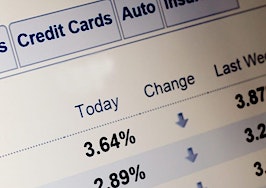- Fannie Mae, Seeking Alpha and First American Financial Corp. recently released data indicating that the housing market is slipping.
- The FHFA, Black Knight and ECRI show the market as stable -- not improving, but not slipping.
- Housing stats have been on a stable up-slope for years, but this evident flattening wobble bears careful watching.
Sometimes I mention “suspicious data” on the way to blowing up the source or the analysis, but this time the sources are all okay and point in a similar direction: The U.S. housing recovery has slipped.
What the sources say
Fannie Mae last week announced that its Home Purchase Sentiment Index slid to an 18-month low. Not a big slide, and survey-based, but a consistent finding by an unbiased source.

Fannie Mae’s HPSI for March 2016.
Seeking Alpha found a distinct topping in new home sales beginning last summer and flattening in just the December-February period. Its analysis does not use units alone — low inventory would account for such a plateau — but instead units multiplied by price, so you’d think rising prices should remove the low-inventory impact.
First American Financial Corp’s Real Estate Sentiment Index found in the first three months of 2016 a 4.4 percent decline in title agents’ expectations for home sales activity from the last three months of 2015. (First American surveys title agents, and I like it when disparate sources come to similar conclusions.) The softness perceived was more in units than price.
Most measures of price are still okay. The best, the FHFA (I’ll get an argument about that…) is still showing national home price gains on a 6 percent annualized centerline, but a new and relatively sudden complete standstill in the Pacific region. CoreLogic is still in about the same 6-percent place, as is Case-Shiller, although it lags the market.
Black Knight’s February “Mortgage Monitor” finds all the bad stuff getting better — delinquencies, foreclosures, and negative equity declining.
Good measures of the overall economy show first-quarter gross domestic production (GDP) soft, only perhaps a half-percent annualized, but slow only because consumers are buying more goods produced overseas than produced here.
Consumers overall are on a 2-percent growth track — down a little from 3 percent last year, but OK.
The ECRI (Economic Cycle Research Institute) has the best long-term recession prediction model of all (only one false call since 1965), and it says the economy is okay — just that, not improving.
Knit this together?
One way to explain the housing pattern: Sales are suppressed in localities with good economies because of limited inventory. Turn affordability on its head: A pricey housing shortage may slow the growth of good economies.
This is a very real puzzle: Where is the new construction to meet demand?
In the rest of the country, there is no acceleration of the economy — and hence not in housing, either.
Housing stats have been on a stable up-slope for years. This evident flattening wobble bears careful watching, as housing has been the only forward propellant of the economy besides the general reduction in unemployment.
Lou Barnes is a mortgage broker based in Boulder, Colorado. He can be reached at lbarnes@pmglending.com.









